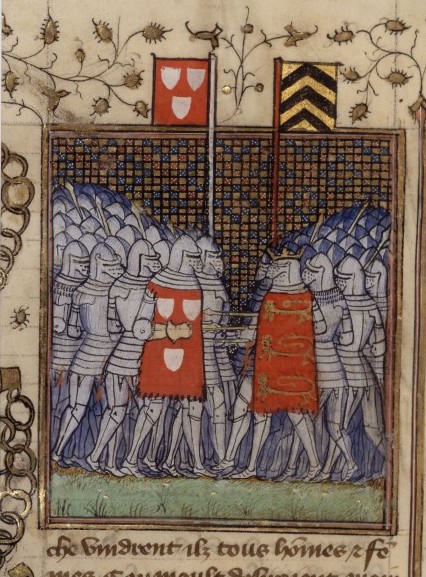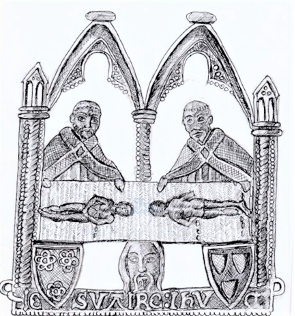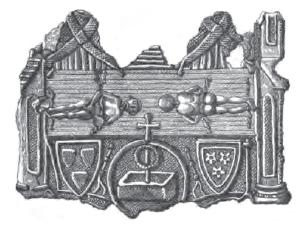The Shroud in the de Charny Family and Disputes Over Its Authenticity
Marcin Grala ![]()
Pontifical University of John Paul II, Kraków, Poland
Ian Wilson called the period from the sacking of Constantinople by participants in the Fourth Crusade till the mid-14th century the missing years. Attempts to clarify the fate of the relic hitherto venerated in the Byzantine capital (→The Shroud in Constantinople) have not yielded satisfactory results. It is likely that the linen initially fell into the hands of Otto de la Roche, who was the first ruler of the Latin principality of Athens. Some scholars—above all the aforementioned I. Wilson and Barbara Frale—allow for the possibility that the Shroud was later in the hands of the Templars for some time (→Templars and the Shroud). This supposition does not explain how the relic found its way to the village of Lirey in Champagne in the mid-14th century, and it is from this point that the history of the Shroud becomes clearer.
Sources that mention the presence of the Shroud in north-eastern France indicate that its owner was Gotfried de Charny (c. 1306–1356), lord of Lirey, Savoisy and Montfort. There are no references to explain how he came into possession of the relics. Margaret de Charny, Gotfried’s granddaughter, stated in one document that the shroud was her grandfather’s spoils of war. As this statement, devoid of details, was made during a time of fierce disputes between Margaret and the canons of Lirey over the right to possess the relics, most scholars reject its credibility.

Supporters of the theory that the Shroud is linked to the Templars point to the sameness of the names, which suggests the possibility of kinship between the knight of Lirey and the knight burned at the stake, along with the order’s Grand Master Jacques de Molay, Commander of Normandy—Gotfried de Charny (†1318). No genealogical research has confirmed family links between the two figures. One answer to the question of how the Shroud found its way to Lirey is that Gotfried de Charny may have become the owner of the linen through marital relations. His first wife, Joan de Toucy, came from a family whose representatives—Nargeaud de Toucy and Philip—held the regency in the Latin Empire for a time, from where they were able to bring the Shroud to France. One of the direct ancestors of Gotfried’s second wife, Joan de Vergy, was in turn the aforementioned Otto de la Roche. Idzi Panic believes that although it is impossible to explain how and when the Shroud came into the hands of the de Charny family, it is rather certain that Gotfrid acquired the linen legally. This is confirmed by the absence of any complaints, disputes or claims by any previous owners of the relics.

The correspondence entered into by Gotfried de Charny in April 1349 with Pope Clement VI regarding permission for the foundation at Lirey, near Troyes, of a collegiate church dedicated to the Annunciation, is the first information suggesting that he may have possessed the Shroud. The uniqueness of this information lies in the fact that the village in question did not previously have a temple of any kind, and that Gotfried’s aim was to create a religious building of fairly high stature, served by a college of five canons. In 1354, the collegiate church under construction was granted a number of privileges by Pope Innocent VI, among which was the possibility for visitors to the temple to obtain an indulgence.
Thanks to the support of King John the Good, the work was completed and the solemn consecration took place in May 1356. The consecration ceremony of the collegiate church was presided over by Henry of Poitiers, Bishop of the Diocese of Troyes, who, on the occasion of the event, praised the founder as a virtuous and pious Christian. The actions taken by Gotfried raised no objections from the ecclesiastical authorities, who were apparently unaware of his possession of the Shroud. All indications are that Gotfried de Charny had not yet decided to make it public, and shortly after completing the foundation he was killed at the Battle of Poitiers (19 September 1356).
The first public presentations of the Shroud took place soon after the death of the founder of the shrine at Lirey. This decision was most likely based on the difficult situation of Gotfried’s widow, who was unable to bear the costs of maintaining the collegiate church. On the advice of the canons, Joan de Vergy decided to organise a solemn veneration of the relic she had inherited from her husband, hoping to have an income generated by the influx of pilgrims. Indeed, from then on, Lirey became a place where pilgrims began to flock to see the cloth bearing the image of Christ’s martyred body. A partially preserved pilgrim’s badge (medallion) is a testimony to these displays. This relic was discovered in 1855 by Parisian merchant and amateur archaeologist Arthur Forgeais in silt excavated from the bottom of the Seine. It is currently stored in the Musée de Cluny in Paris.


The partially damaged openwork emblem contains the coats of arms of the Charny and Vergy families. The former is on the heraldic right, the “privileged,” side of the medallion, suggesting that the emblem was created when Gotfrid II, son of the first owner of the Shroud, was lord of Lirey. In 2009, a damaged badge mould was found in the fields of the neighbouring village of Machy, adjacent to Lirey, for pilgrims coming to the de Charny estate to see the Shroud. Unlike the badges from the Seine, the medallions embossed with this mould had a completely opposite arrangement of coats of arms, which—as demonstrated in his recent study by I. Wilson—is a testimony to the first displays of the Shroud initiated around 1357 by Joan de Vergy. This may be confirmed by the low quality of the mould, which must have been made in haste and with little money.
The public display of the Shroud caused an outcry from the local church authorities. According to a memorandum written at the end of 1389 by Bishop Peter d’Arcis addressed to Pope Clement VII, this practice had been going on for more than 30 years and had already been opposed by his predecessor Henry of Poitiers. The Ordinary of the Diocese of Troyes thoroughly investigated the matter and came to the conclusion that the Shroud on display in Lirey was a skilfully painted forgery and that the whole mystification was aimed at profiting from misled pilgrims. As Peter d’Arcis recounts, the objections of Bishop Henri and his advisers stemmed, among other things, from the fact that none of the Gospels mentions such a likeness of Christ; an investigation also revealed the testimony of an artist who claimed to have painted the linen by some unusual means. Thus, the memorandum became the first testimony that the Shroud was a forgery and an artificial painting (fraudem, artificaliter depictus). When Bishop Henry began to take action to officially ban the display of the cloth, the canons stopped the display and hid the relic. According to the writings of Peter d’Arcis, after more than 30 years the Shroud began to be presented to pilgrims again. This time, Gotfrid II prepared himself for possible accusations from some of the church authorities and, concealing the essence of the conflict from the time of Bishop Henry of Poitiers, obtained from the papal legate the right to display the Shroud. As a precaution, he also informed the representative of the Holy See that there would be a display of the image of the Shroud of Christ in Lirey. Thus, at the suggestion of Peter d’Arcis, the misled legate, without consulting the bishop, gave permission for a public display. The author of the memorandum pointed out that the resumption of the display of the Shroud was done on the basis of an “extortionate consent” and had an extremely solemn form, surpassing even the adoration of the Blessed Sacrament. The bishop mentioned that although officially the image was not called the Shroud of Christ, the ceremonies and discreet suggestions led people to believe in the authenticity of the relic. Peter d’Arcis informed the Pope that, aware of all the objections and out of concern for the souls of his diocese, he had forbidden the canons of Lirey from making any further displays. These, heedless of the threatened penalty of excommunication, appealed to the king and the pope together with Gotfrid II and continued the public display of the Shroud. At the end of his memorandum, the Bishop of Troyes regretted not having the support of Clement VII, since he, like the legate, had been misled by Monsieur de Charny.
The authenticity of the Shroud is challenged by: the mention in the memorandum of Peter d’Arcis that the alleged relic is in fact a skilfully executed painting; the fact that the existence of the cloth, which is now kept in Turin, is only confirmed by sources from the mid-14th century; and the results of radioactive carbon dating, which suggest that the Shroud was made between 1260 and 1390. Opponents of this point of view point out that the bitter accusations made in the Bishop of Troyes’ letter do not contain specific information. There are no sources that spoke of the action taken by Bishop Henri, the name of the alleged artist is not mentioned and the manner in which the image was made is described inconsistently. The credibility of Peter d’Arcis’s opinion may also be in doubt because the bishop did not have the opportunity to examine the contested object directly. It is also not insignificant that the creation of a forgery capable of imitating Christ’s funerary cloth so effectively would have had to be extremely expensive, while the economic situation of the de Charny family after the death of Gotfried I was quite difficult. Moreover, despite the alarmist tone of the Bishop of Troyes and his lively correspondence with Avignon, in the end Clement VII did not ban the display of the Shroud. The pope’s decision of 6 January 1390 allowed the canons of Lirey to publicly display the cloth, only with certain ceremonial restrictions and with a clear indication that the material on display was an ‘image’ and ‘likeness’ and not an authentic relic. The Pope’s decision did not settle the authenticity of the Shroud, but offered a compromise solution to the dispute. The objections of Peter d’Arcis were overcome and the bishop himself was ordered to remain silent on the matter. As we do not know of any further objections being raised, we conjecture that the Ordinary of the Diocese of Troyes strictly adhered to the papal recommendation until the end of his life on 18 April 1395.
After the death of Gotfried II (22 May 1398), the Shroud, which was kept in the collegiate church of Lirey, became the property of his daughter, Margaret de Charny. It is not known how often displays and adorations of the linen were organised, as times were quite turbulent. The growing mental illness of King Charles VI sparked power struggles that eventually escalated into a civil war between the Burgundians and the Armagnacs. France’s precarious internal situation was exploited by the English, who, resuming hostilities, launched the next phase of the Hundred Years’ War. After the defeat of the French at the Battle of Agincourt in 1415, in which John de Bauffremont, Margaret’s first husband, was killed, the country descended into even more chaos. The situation was also unsettled in Champagne and around Lirey, which threatened the safety of the relics. Given the circumstances, Margaret and her new husband, Humbert de Villersexel, decided in July 1418 to temporarily move the Shroud and other precious objects from the collegiate church founded by her grandfather to the castle of Montfort. In the receipt issued to the canons of Lirey, Humbert mentioned, among other things: A canvas bearing the likeness or representation of the Shroud of our Lord Jesus Christ, contained in a casket decorated with the de Charny coat of arms (Wilson 1983, p. 252). Over the following years the Shroud was kept at Montfort near Montbard and at Humbert’s ancestral seat at St Hippolyte-sur-le-Doubs, where several displays were organised.
After the death of Margaret’s second husband in 1438, when the situation in France had stabilised, the canons of Lirey asked her to return the possessions she had taken away years earlier. The granddaughter of Gotfried I refused to hand over the valuables and the Shroud to the clergy, and over the following years she sued them for the right to possess the relics. Margaret was a childless widow, so her actions may have been motivated by a desire to guarantee her financial security for the last years of her life. Disputes with the canons of Lirey were settled by the court of Dôle, which in May 1443 ordered her to surrender to the clergy the goods taken from Lirey in 1418. In defiance of the verdict, the Shroud remained in the hands of Gotfried de Charny’s granddaughter. Seeing her resistance and determination, the court ended the subsequent trial with an amicable solution: in return for paying the canons compensation, Margaret was allowed to keep the relic for three years. When, in 1449, the clerics of Lirey realised that, again, the Shroud would not be surrendered to them, they turned to the court of Besançon. By a subsequent judgment, Margaret was allowed to keep the linen for the next two years.
During the period of disputes with the canons of Lirey, Margaret organised adorations of the Shroud in various places. In 1449, the relic was presented in Chimay, Belgium, which did not please the authorities of the diocese of Liège, and in 1452 a solemn exposition of the Shroud was held at the castle of Germolles near Mâcon, France. Probably Margaret, who was already of advanced age, when organising the displays of the linen, was looking for wealthy patrons who could help her in her disputes with the canons of Lirey and, in the long term, give the relic proper care. In the end, she decided to donate the Shroud to the House of Savoy. During one of Margaret’s visits to Geneva, where several displays of the Shroud were organised, on 22 March 1453, Duke Louis of Savoy issued a document by which his granddaughter Gotfried de Charny received the castle of Varambon and the proceeds of the Miribel estate near Lyon. According to the ducal deed, the generous goods bestowed on her were a reward for valuable favours. This mysterious term helped to conceal the real reason for the donation, which was the sale of the Shroud, in contravention of the provisions of the Fourth Lateran Council, which forbade the trade in relics. In the meantime, the canons of Lirey succeeded in having Margaret punished with excommunication, which was proclaimed by the episcopal curia of Besançon on 30 May 1457. The last owner of the Shroud of the de Charny family died on 7 October 1459 without reconciliation with the Church. While she was still alive, the canons of Lirey realised that the relic was in the hands of an overly powerful family and gave up further attempts to recover the Shroud, concentrating only on negotiating financial compensation. In 1464, Louis of Savoy granted them an annual annuity, thus freeing Margaret’s soul from ecclesiastical punishment. The new owners of the Shroud ensured that the extraordinary relic was properly venerated and in the following years it came to serve as the palladium of the House of Savoy.
References
Chavalier U., Autour des origines du suaire de Lirey, avec documents inédits, “Bibliothèque liturgique” 1903, Vol. 5, No. 4, pp. 5–53.
Fossati L., A Critical Study of the Lirey Documents, “Shroud Spectrum International” 1992, No. 41, pp. 2–11.
Fossati L., La Santa Sindone. Nuova luce su antichi documenti, Torino 1961.
Fossati L., The Lirey Controversy, “Shroud Spectrum International” 1983, No. 8, pp. 24–34.
Frale B., Całun Jezusa Nazarejczyka, przeł. G. Rawski, Kraków 2012.
Frale B., Templariusze i Całun Turyński, przeł. G. Rawski, Kraków 2011.
Marion A., Courage A.L., Całun Turyński. Nowe odkrycia nauki, przeł. P. Murzański, Kraków 2000.
Nicolotti A., The Acquisition of the Shroud by the House of Savoy. Documentary Evidence, [in:] The Shroud at Court: History, Usages, Places and Images of a Dynastic Relic, eds. P. Cozzo, A. Merlotti, Nicolotti A., Leiden–Boston 2019, pp. 20–56, https://doi.org/10.1163/9789004390508_004.
Nicolotti A., Marguerite de Charny, François de La Palud e Ludovico di Savoia, due documenti inediti, “Bollettino storico-bibliografico subalpino” 2018, Vol. 116, No. 1, pp. 191–209, http://hdl.handle.net/2318/1671358.
Panic I., Tajemnica Całunu, Kraków 2010.
Saxer V., Le Suaire de Turin aux prises avec l’historie, “Revue d’histoire de l’Église de France” 1990, Vol. 76, No. 196, pp. 21–55, https://doi.org/10.3406/rhef.1990.3483.
Waliszewski S., Całun Turyński dzisiaj, Kraków 1987.
Wilson I., Całun Turyński, przeł. A Polkowski, Warszawa 1983.
Wilson I., The Earliest Pilgrim Badges Produced for the So-Called ‘Shroud of Turin’, “Peregrinations: Journal of Medieval Art and Architecture” 2021, Vol. 7, No. 3, pp. 174–211, [on-line:] https://digital.kenyon.edu/perejournal/vol7/iss3/6.
Sources of Images
1. Wikimedia Commons, CC License, source: https://commons.wikimedia.org/wiki/File:Blason_famille_fr_Charny.svg (Bruno, CC BY-SA 3.0)
2. Wikimedia Commons, https://commons.wikimedia.org/wiki/File:Eduard3_Charny.jpg (public domain)
3. Wikimedia Commons, https://commons.wikimedia.org/wiki/File:Shroud_Pilgrim_Badge_discover_recently_in_Machy.png (MLK Halifax, CC BY-SA 4.0)
4. Wikimedia Commons, https://commons.wikimedia.org/wiki/File:Shroud_of_Lirey_Pilgrim_Badge.jpg (public domain)
